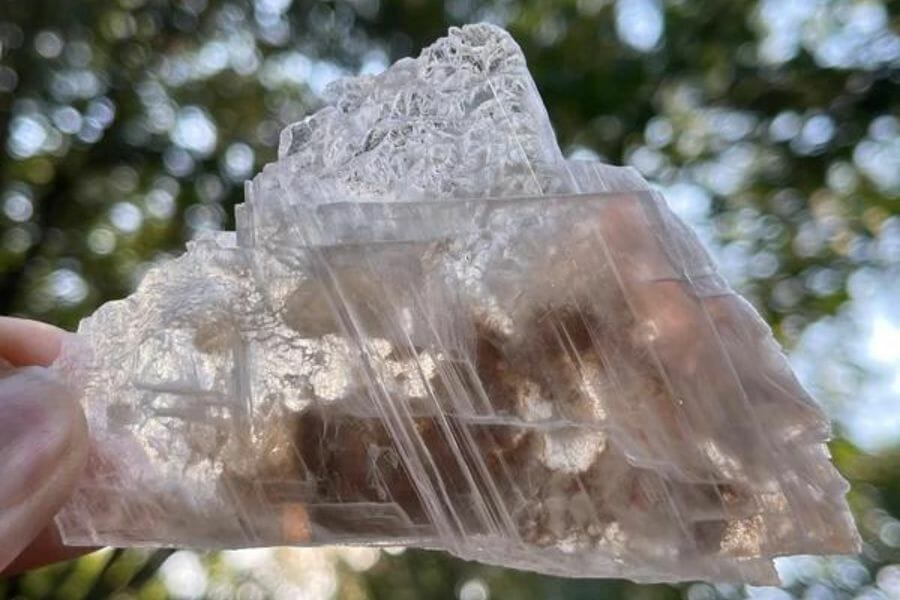Finding crystals can be a rewarding adventure, offering a unique way to explore the natural beauty and geology of the region. Whether you’re a seasoned rockhound or just getting started, knowing where to look is key to uncovering these hidden treasures.
In this state, a variety of locations provide opportunities to discover different types of crystals. From rocky outcrops in the mountains to stream beds that carry sparkling surprises, each area offers its own unique finds for those willing to search.
We can help you get started with some places you can explore for crystals below!
Crystals you can find in the US
The United States offers a wide range of crystals that reflect its diverse geology. From vibrant gems to more subtle mineral formations, there’s something to discover in nearly every region.
Calcite
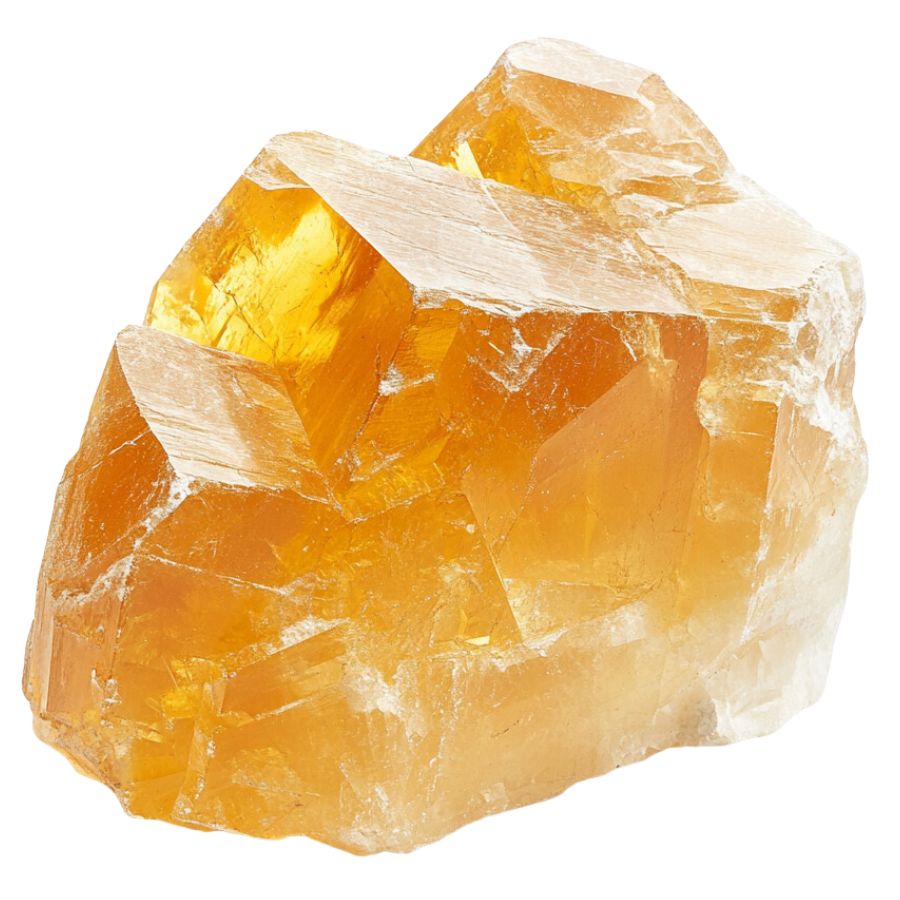
With a variety of forms and a unique property of double refraction, calcite allows objects viewed through the crystal to appear doubled. This mineral can appear in a spectrum of colors, with pure forms typically being transparent or white.
In addition, calcite reacts vigorously with acids, which aids in distinguishing it from other minerals. It also frequently contributes to the structure of sedimentary rocks such as limestone.
Gypsum
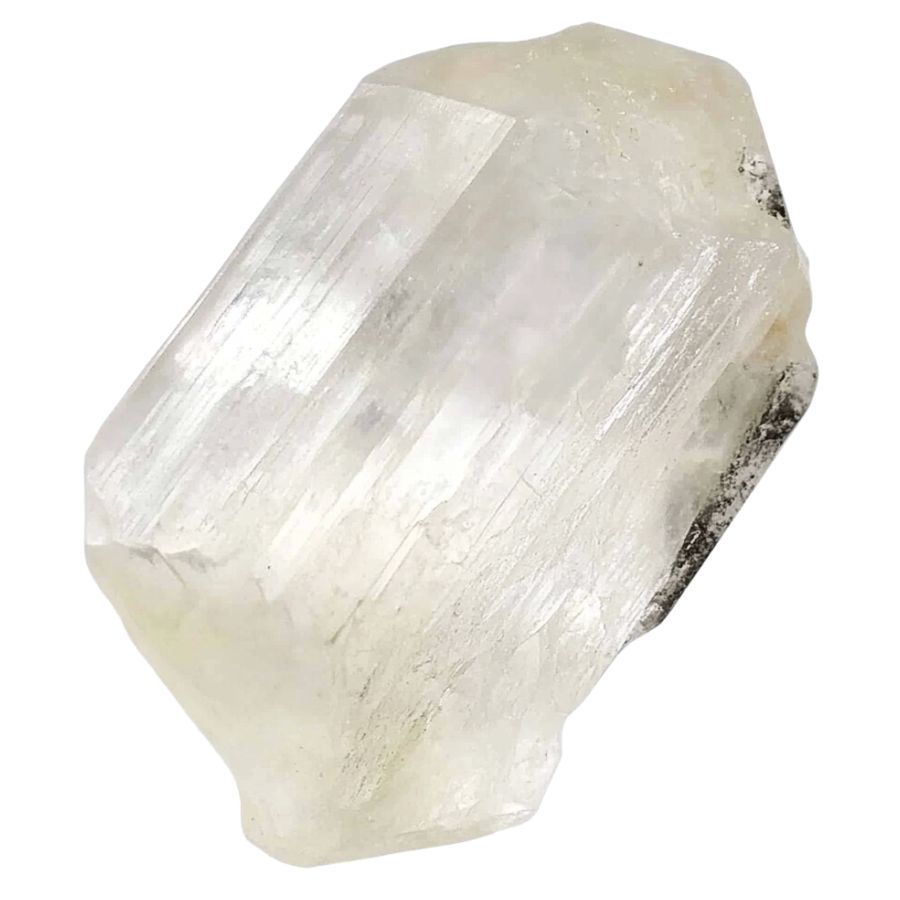
Gypsum’s notable softness allows it to be easily scratched with just a fingernail, often presenting as white or very light-colored in its pure form.
It manifests in both crystalline forms, like selenite, and massive forms such as alabaster, making it versatile in use and appearance.
Gypsum is also essential in the construction industry and is a key component in the manufacture of plaster and drywall.
Fluorite
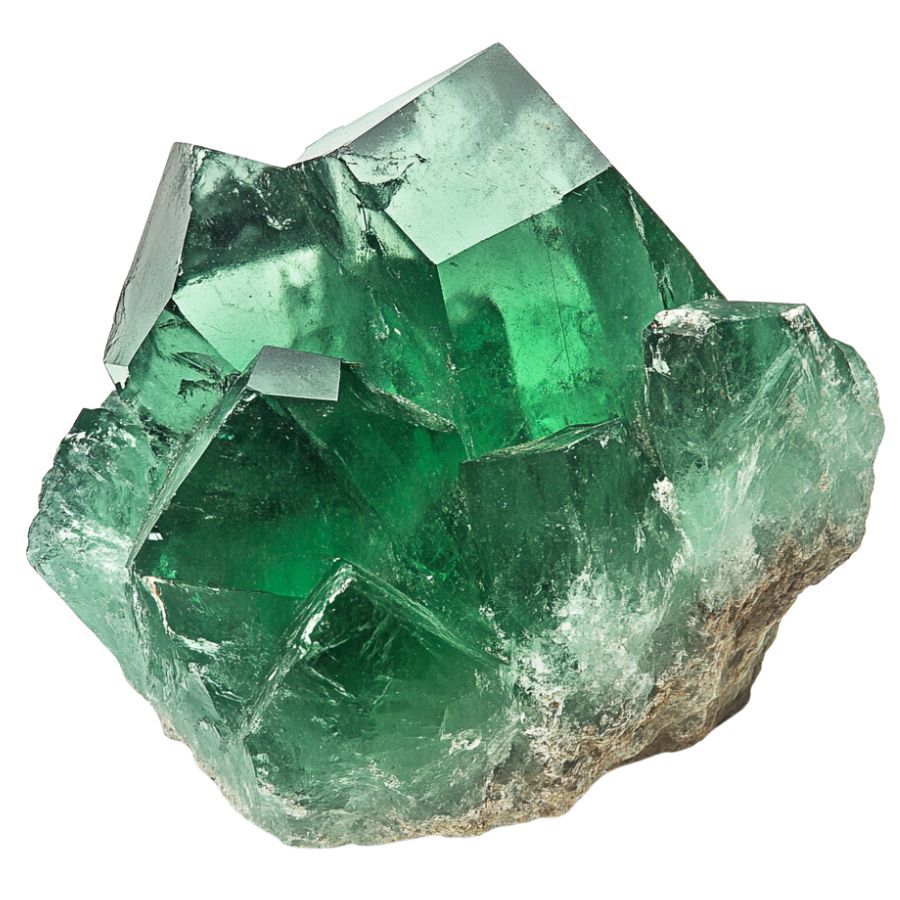
Fluorite comes in a wide range of vibrant colors, including purples, greens, blues, and yellows, and is known for forming in well-defined cubic crystals.
Beyond this, fluorite exhibits fluorescence under ultraviolet light! It can also be used in various industrial applications, including as a flux in steelmaking.
Galena
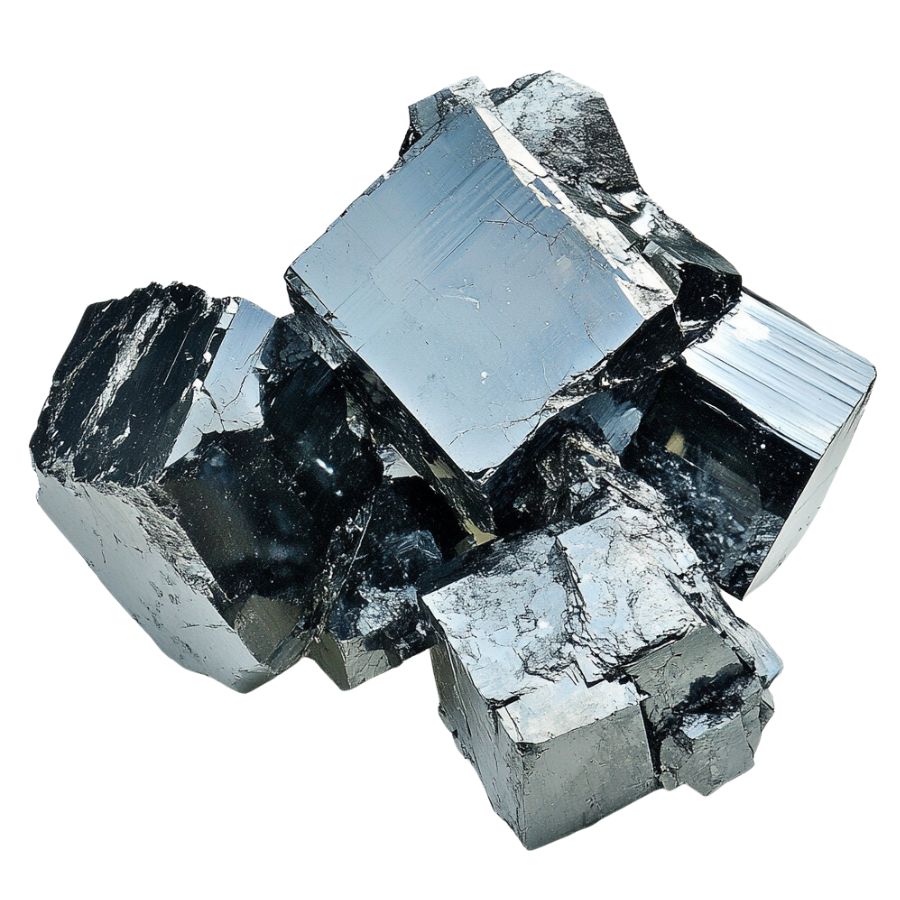
Galena distinguishes itself with a metallic luster and high density, typically found in a cube-like form. It serves as the primary ore of lead, making it important in the metal industry, while its shiny, silver color attracts collectors.
Not only does its appearance make it a subject of interest, but its weight and texture provide tangible lessons in mineral density and metallic properties. Galena also often contains traces of silver, adding to its commercial and educational value.
Corundum
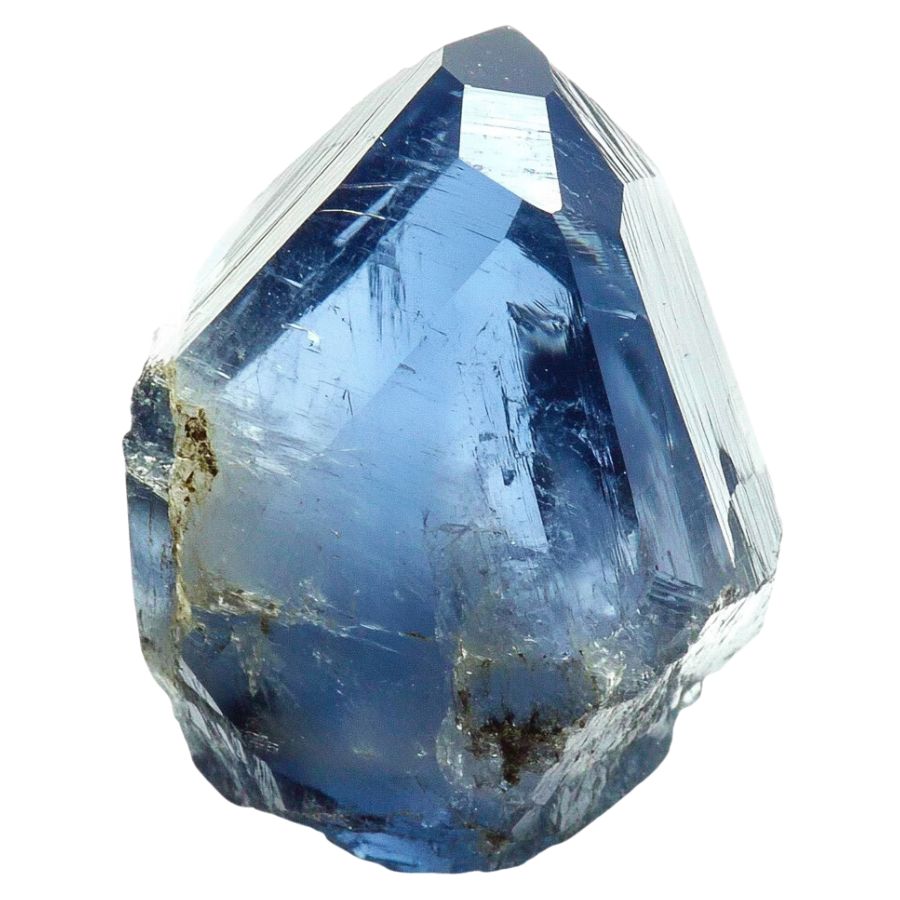
Corundum is a mineral that comes in a variety of colors, though it is typically transparent or gray. Its most famous forms are sapphires and rubies, which are prized for their vibrant blue and red hues.
The mineral is known for its remarkable hardness, ranking just below diamond on the Mohs scale. This durability makes corundum ideal for industrial abrasives and cutting tools, as well as a popular choice for fine jewelry.
Quartz
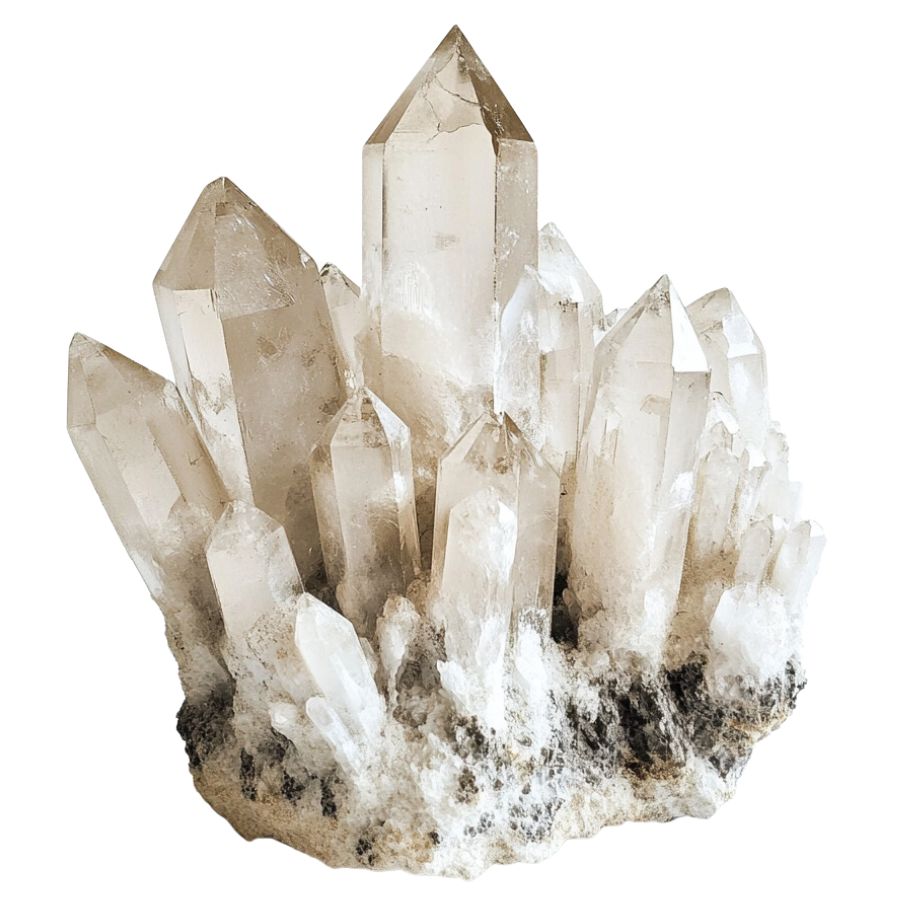
Quartz is among the most common minerals in the Earth’s crust and is prized for its durability and variety. It forms in a wide range of colors and types, from clear rock crystal to purple amethyst.
The mineral is notable for its hardness and durability, which contribute to its use in a variety of applications. Quartz is also popular in the manufacturing of electronics and watches due to its piezoelectric properties, which allow it to convert mechanical pressure into electrical energy.
Pyrite
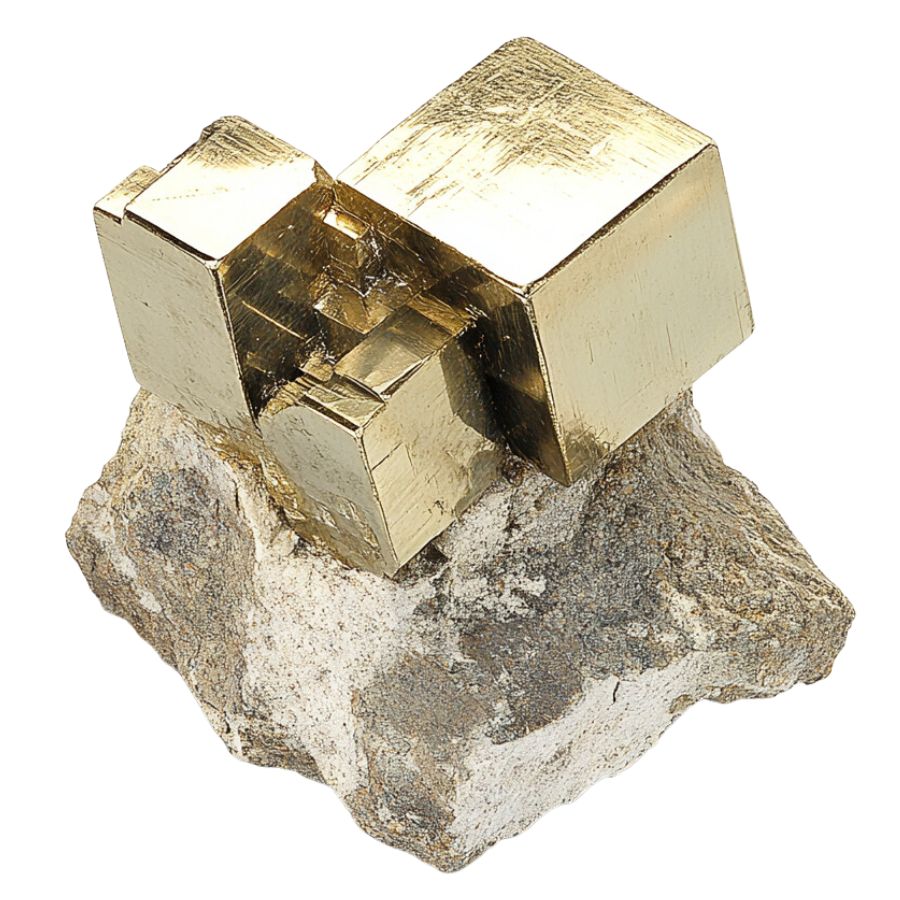
Often mistaken for gold due to its metallic luster and pale brass-yellow hue, pyrite is known colloquially as “fool’s gold.” Its characteristic cube-shaped crystal formations look man-made but are actually completely naturally formed!
Pyrite also has historical importance in producing sulfur dioxide for sulfuric acid production.
Rhodochrosite
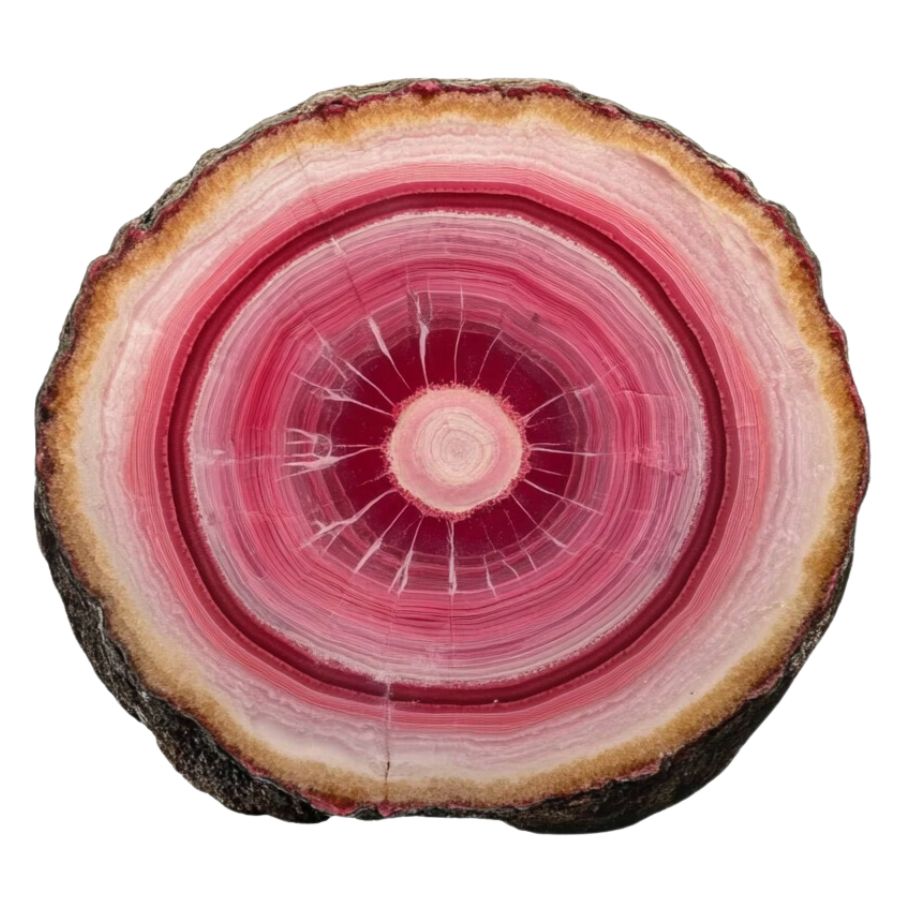
Rhodochrosite stands out with its rich pink and red hues, making it highly desirable as both a mineral specimen and a gemstone.
It typically forms in layered or stalactitic structures, with bands of colors that showcase how it grew over millions of years.
Beyond its beauty, rhodochrosite is significant as the main source of manganese, an essential element used in metal alloys.
Rhodonite
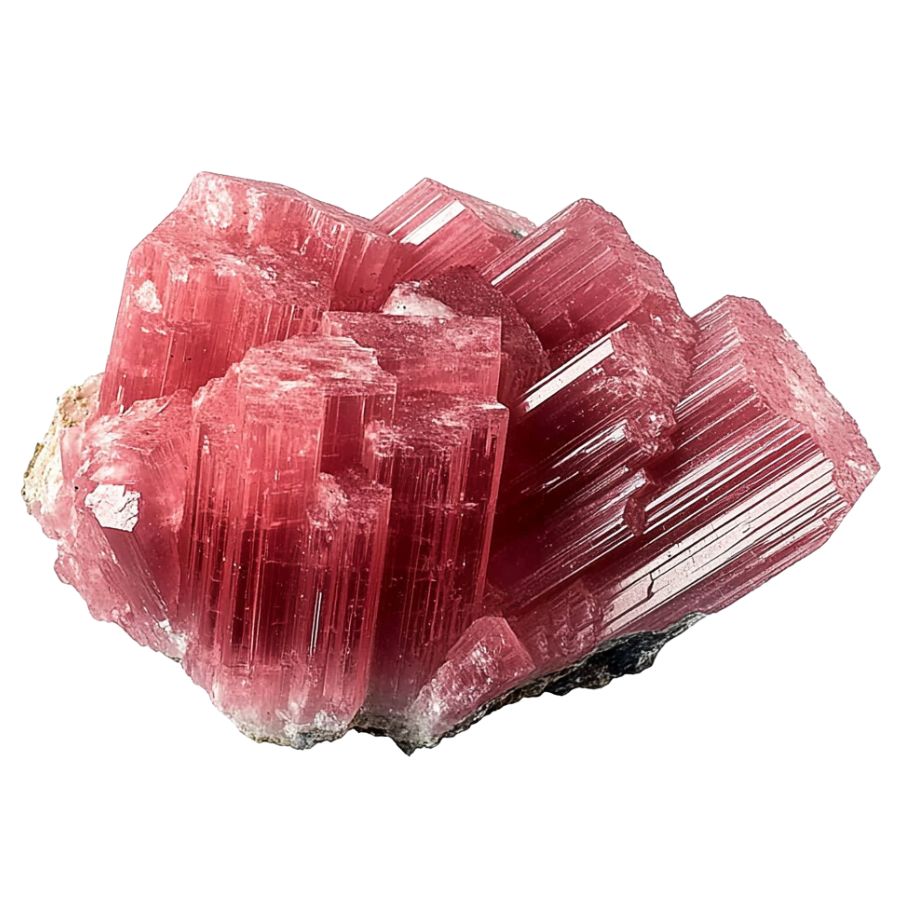
Appreciated for its deep pinks and reds, often complemented by black manganese oxide veins, rhodonite presents a dramatic appearance. It is typically found in metamorphic rocks and is used both as an ornamental stone and in jewelry.
In geology, rhodonite is significant for its role in metamorphic processes and its association with other manganese-rich minerals. It can be found in metamorphosed sedimentary rocks and is sometimes used as an indicator of the presence of manganese deposits.
Vivianite
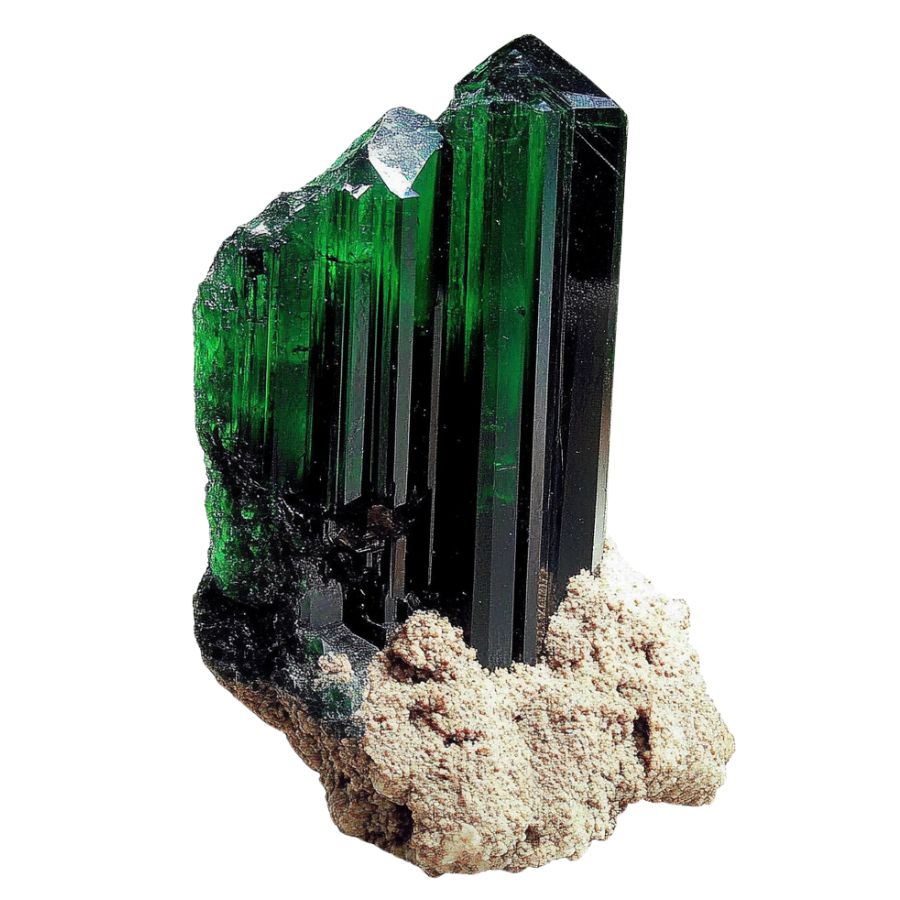
Vivianite, an iron phosphate mineral, emerges in low-oxygen environments like peat bogs or iron-rich deposits. Its striking blue to green color, which can change to a lighter shade over time due to oxidation, makes it a distinctive mineral.
Found in various geological settings, vivianite provides clues about the local conditions and the presence of phosphate deposits.
The Types of Indiana Crystals You Can Find
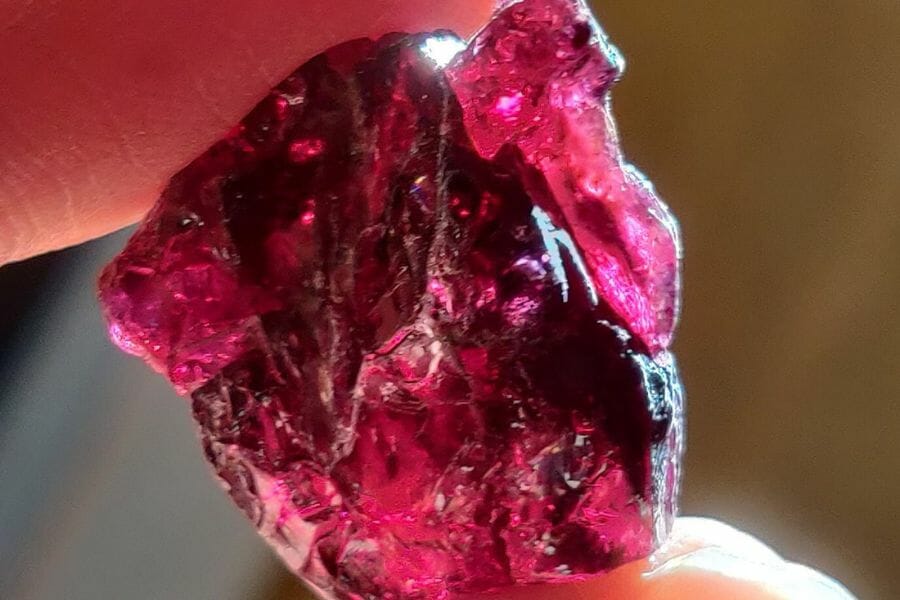
Crystals are stunning mineral formations that have been around for millions of years. These natural wonders are often found in geodes or veins in rocks and can be made up of various minerals. The best places to find crystals here are in old mines, quarries, and natural formations like creeks and rivers. Keep your eyes peeled for areas with exposed bedrock, as crystals can be found in cracks and crevices.
It’s worth noting that crystal hunting can be a bit of a gamble. Sometimes you’ll find a treasure trove of crystals, and other times you might come up empty-handed. But that’s all part of the fun, right? The thrill of the hunt is half why crystal hunting is such a popular hobby!
Rare crystals found in Indiana
- Agate
- Chalcopyrite
- Garnet
- Hematite
- Jasper
- Moonstone
- Sapphire
More common crystals found here
- Apatite
- Calcite
- Diamond
- Fluorite
- Pyrite
- Quartz
- Selenite
- Topaz
What rough crystals look like
When you’re out looking for crystals on your own it’s important to know what you’re looking for. This is what you need to look out for:
Look for exteriors like this
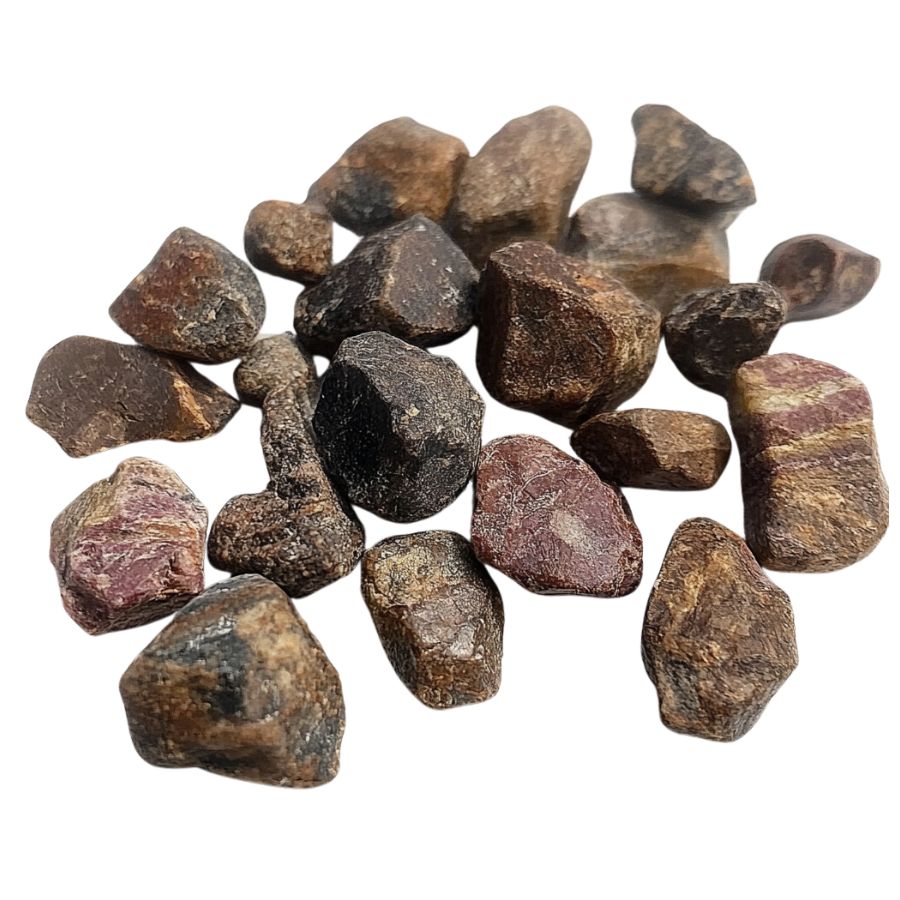
When you’re out searching for crystals in the wild, it’s essential to keep in mind that what you find won’t look like the polished stones you see in stores. One important tip is to consider what certain crystals look like in their raw, natural form.
Without the shine and smooth finish, crystals might appear rough, with jagged edges or earthy tones masking their true beauty. Understanding this can help you spot potential finds that might otherwise be overlooked.
Examine the crystal structure and shape
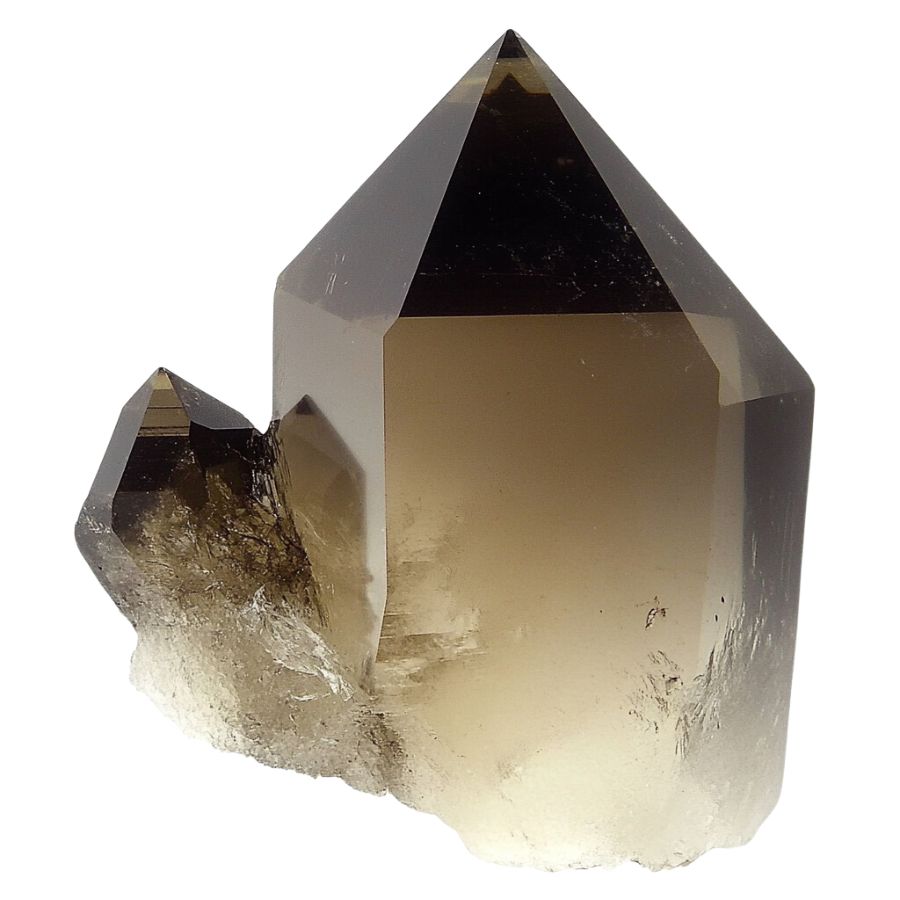
Crystals often form in specific geometric patterns that can be key to identifying them. For example, quartz is known for its hexagonal prisms, while halite typically forms cubic shapes.
By recognizing these distinct patterns, you can differentiate between various types of crystals and better understand what you’ve found.
Observe color
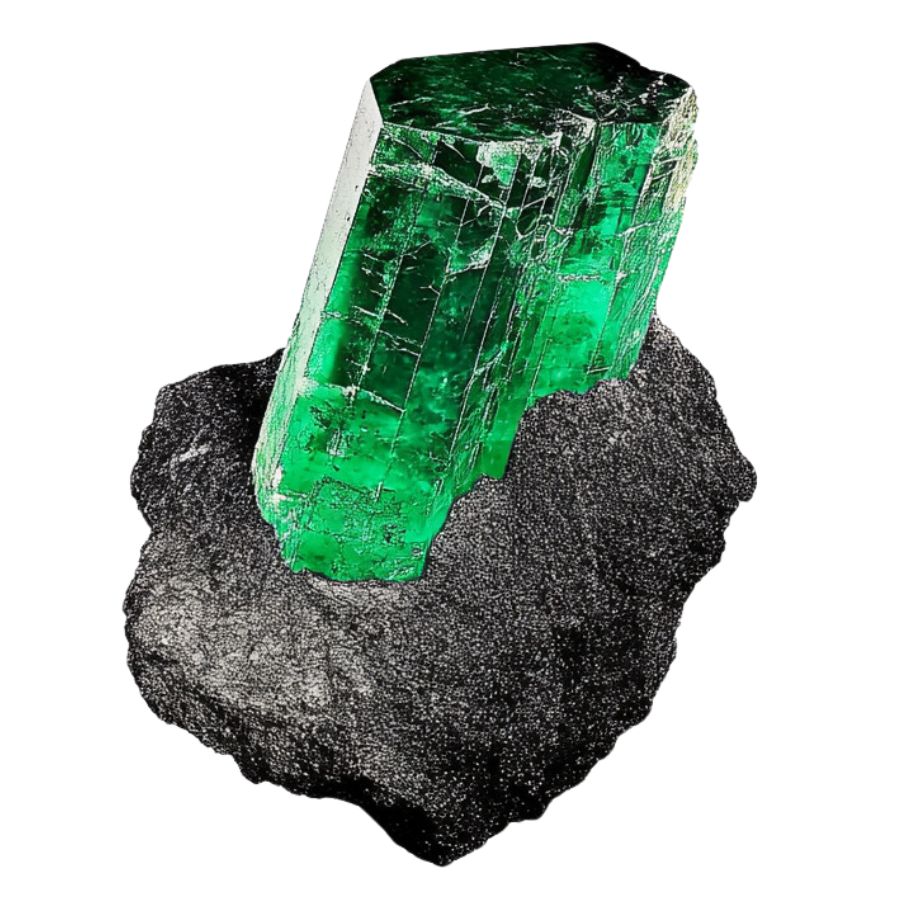
Some crystals are known for their distinct hues, like the deep purple of amethyst or the vibrant green of emerald. However, not all crystals will have strong colors; some may be clear or only slightly tinted.
Check the luster
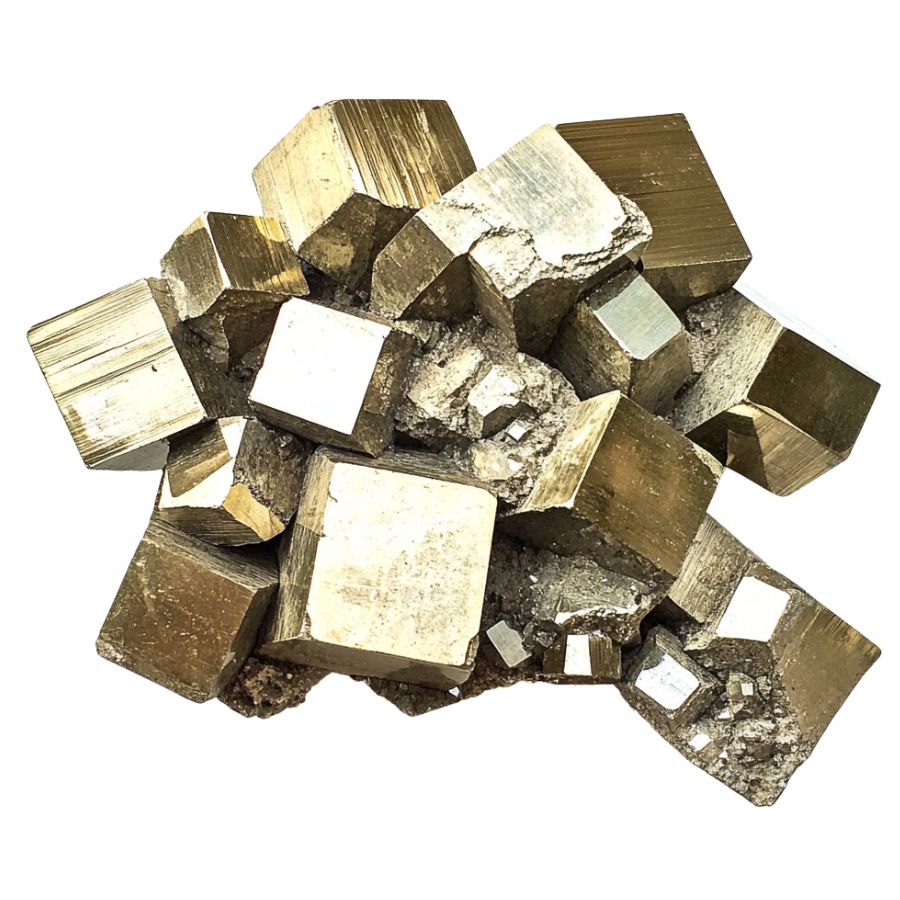
Luster refers to how a crystal’s surface interacts with light. Some crystals might have a shiny, glassy luster, while others may appear metallic or dull. This characteristic can help you determine the type of crystal you’ve found.
However, it’s important to remember that luster isn’t always obvious right away. In some cases, a crystal’s true luster will only become apparent after it’s been cleaned or polished, so keep this in mind as you examine your finds.
Evaluate the transparency
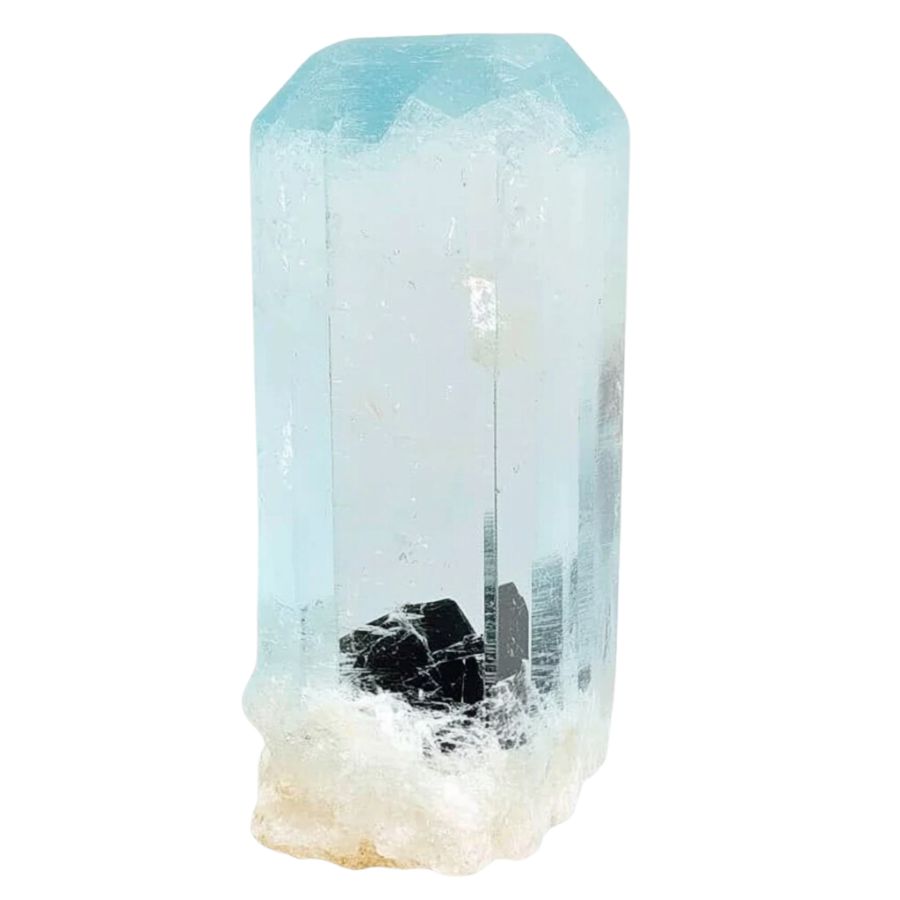
Pay close attention to how much light passes through the crystal. Some crystals are completely clear, allowing light to pass through easily, while others may be opaque and block light entirely.
You might also encounter crystals with translucent edges but opaque centers. These variations in transparency can offer valuable clues about the type of crystal you’ve found, making it easier to identify and appreciate your discovery.
A Quick Request About Collecting
Always Confirm Access and Collection Rules!
Before heading out to any of the locations on our list you need to confirm access requirements and collection rules for both public and private locations directly with the location. We haven’t personally verified every location and the access requirements and collection rules often change without notice.
Many of the locations we mention will not allow collecting but are still great places for those who love to find beautiful rocks and minerals in the wild without keeping them. We also can’t guarantee you will find anything in these locations since they are constantly changing.
Always get updated information directly from the source ahead of time to ensure responsible rockhounding. If you want even more current options it’s always a good idea to contact local rock and mineral clubs and groups
Tips on where to look
Having a better idea of where to look can greatly narrow down your search and increase your chances of finding crystals. By focusing on environments where crystals are likely to be exposed, you can spend less time searching and more time discovering.
Outcrops and Exposed Rock
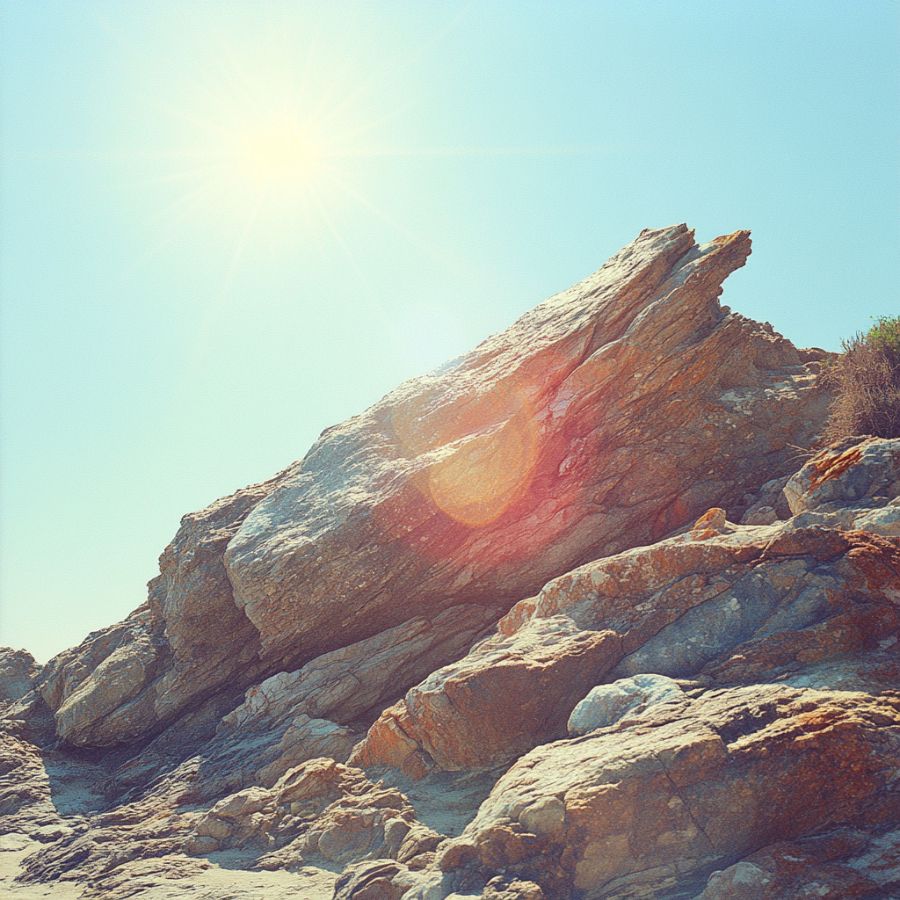
Rocky outcrops are prime locations for finding crystals and minerals. Search along the edges of outcrops, particularly where erosion has worn away the surrounding soil, revealing the rock underneath.
Pay close attention to any visible cracks, crevices, or small cavities within the outcrop, as these are often where crystals develop and can be extracted with minimal effort.
Stream Beds and Gravel Deposits
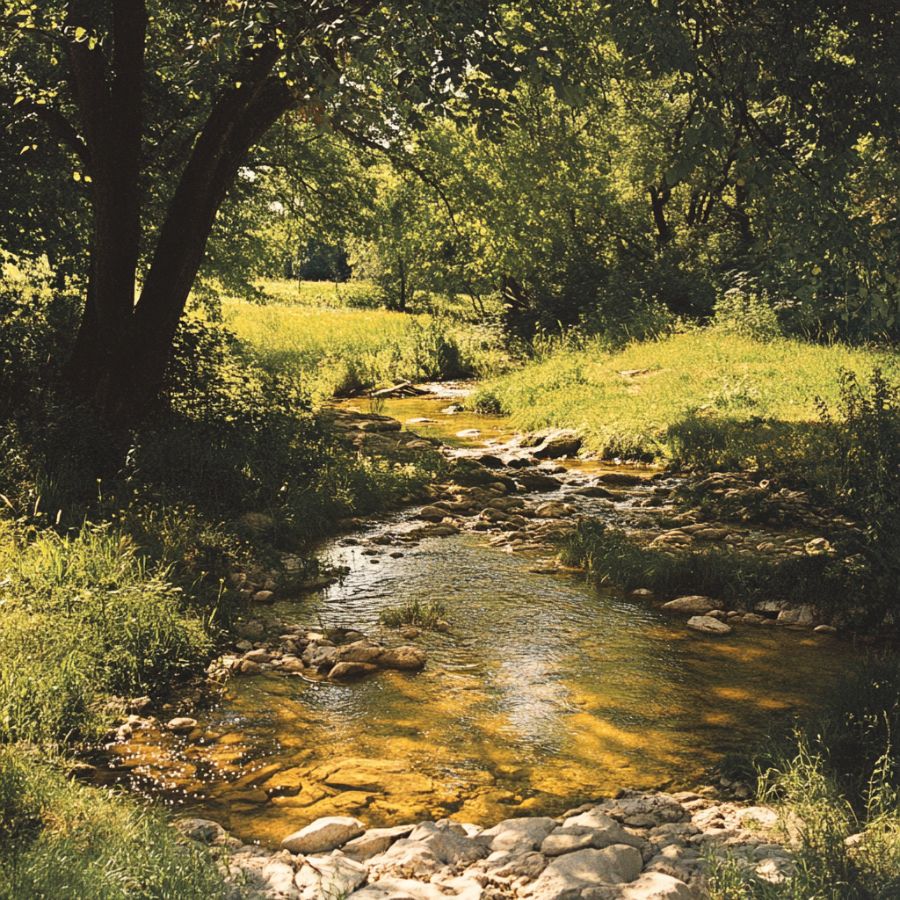
Stream beds are dynamic environments where water flow constantly shapes the landscape. Over time, water can erode rocks upstream, breaking them down and carrying mineral fragments, including crystals, downstream.
When searching in these areas, look for spots where the current has slowed, such as bends in the stream or areas behind large rocks, as these are prime locations for deposits.
Quarries and Mines
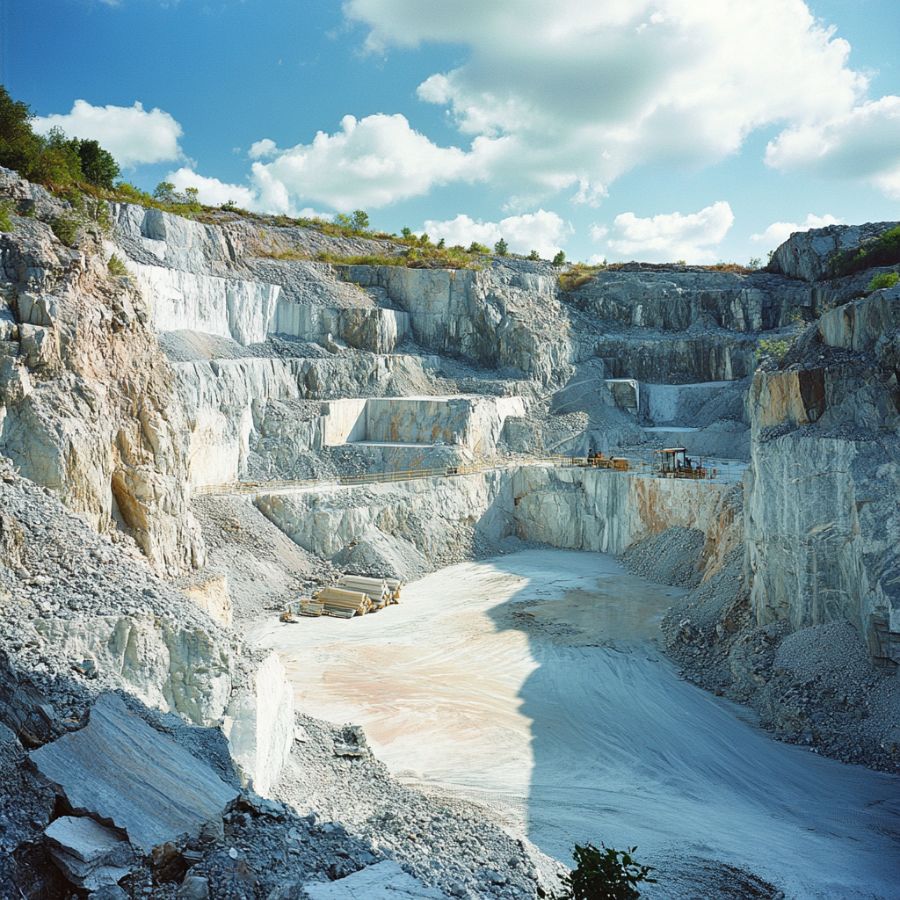
Quarries and mines are excellent places to search for crystals because they expose deep layers of rock that would otherwise be hidden beneath the surface. These sites often contain a variety of minerals and crystals that have been brought to the surface during excavation.
Pay attention to tailings piles, where waste rock is discarded, as they often contain overlooked or broken crystals. Always prioritize safety when exploring these areas and ensure that you have permission to search.
Road Cuts and Construction Sites
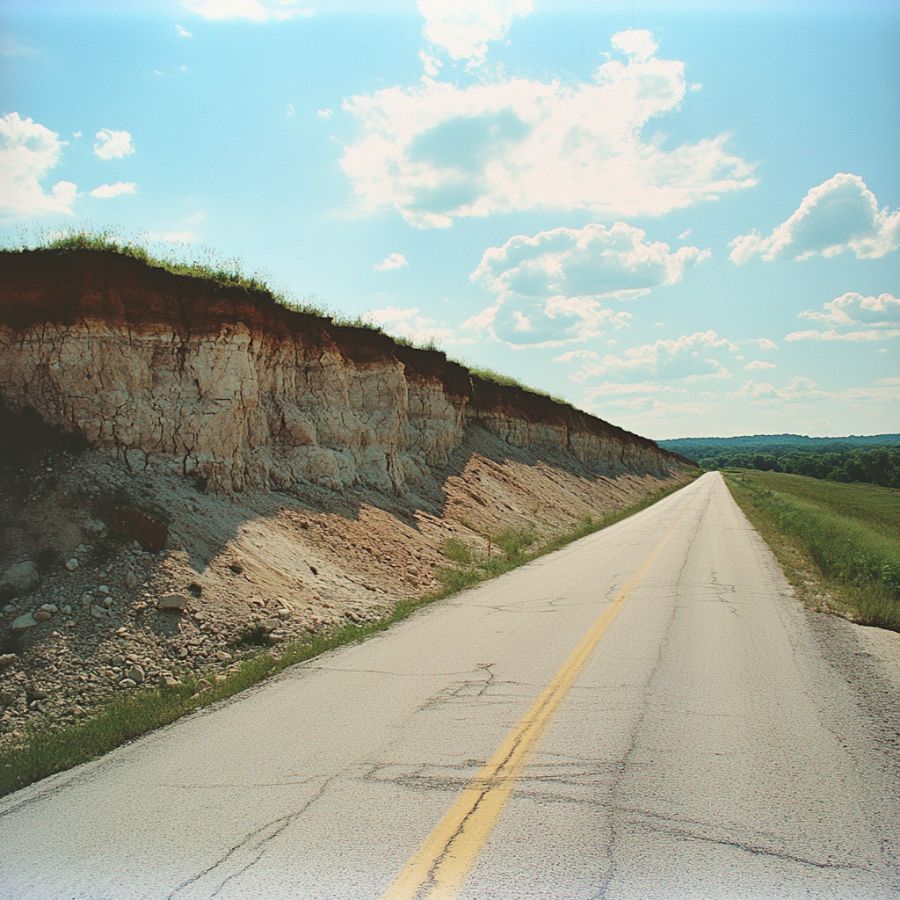
As roads are cut through hillsides or construction projects dig deep foundations, layers of rock and soil that have been undisturbed for millions of years are suddenly exposed.
Look for freshly exposed rock faces, especially where blasting has occurred, as this can create fissures or expose pockets filled with crystals. Be cautious around active construction sites, and always seek permission before exploring.
Mountainous Areas

In mountainous regions, erosion caused by wind, rain, and ice can wear away the softer rock, exposing harder crystals that have formed within. Focus on weathered and broken rock formations.
Look for scree slopes, where loose rock has accumulated at the base of cliffs. Additionally, areas near fault lines or volcanic vents are particularly promising, as they often have a higher concentration of minerals.
DON'T MISS OUT ON ANY GREAT FINDS!
While you're out searching for Crystals you're going to find A LOT of other interesting rocks and minerals along the way. The last thing you want to do is toss out something really interesting or valuable. It can be easy to misidentify things without a little guidance.
We've put together a fantastic field guide that makes identifying 140 of the most interesting and valuable rocks and minerals you will find REALLY EASY. It's simple to use, really durable, and will allow you to identify just about any rock and mineral you come across. Make sure you bring it along on your hunt!
Indiana Crystal Mining Laws And Regulations
In Indiana, recreational crystal hunting is allowed on public land if specific rules or regulations do not prohibit it. However, it is important to note that some private land may be off-limits for crystal hunting, so getting permission before exploring the private property is always a good idea.
Additionally, it’s important to follow all state and federal laws and regulations of the Indiana Department of Natural Resources when crystal hunting. This includes obtaining necessary permits and following guidelines for collecting and removing rocks and minerals from public lands.
It’s also important to practice responsible crystal hunting by leaving the area as you found it and avoiding damaging any natural formations or wildlife habitats. Always respect the environment and other individuals who may be enjoying the area.
- The extensive local experience and understanding of our team
- Input from multiple local crystal hunters and crystal collecting groups
- The accessibility of the crystal mining locations
- Safety and potential hazards when collecting
- Private and public locations
- A desire to include locations for both experienced crystal hunters and those who are just starting out
Using these weights we think we’ve put together the best list out there for those who love finding new crystals for our collections!
The Best Locations For Crystal Mining in Indiana
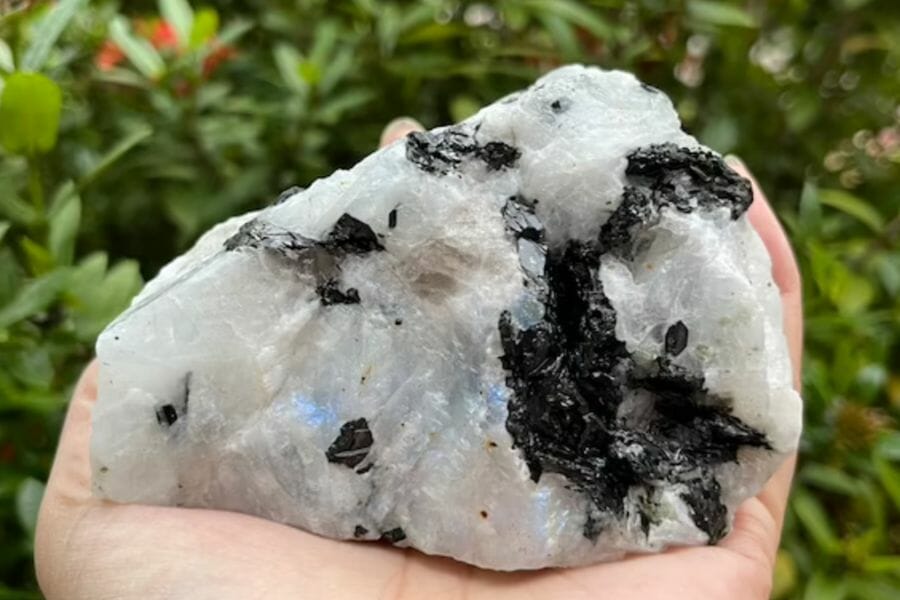
Here are some of the top Indiana locations for crystal hunting. We’ve had a lot of luck exploring them and finding unusual crystals, and we have no doubt you will, too!
Always Confirm Access and Collection Rules!
Before heading out to any of the locations on our list you need to confirm access requirements and collection rules for both public and private locations directly with the location. We haven’t personally verified every location and the access requirements and collection rules often change without notice.
Many of the locations we mention will not allow collecting but are still great places for those who love to find beautiful rocks and minerals in the wild without keeping them. We also can’t guarantee you will find anything in these locations since they are constantly changing.
Always get updated information directly from the source ahead of time to ensure responsible rockhounding. If you want even more current options it’s always a good idea to contact local rock and mineral clubs and groups
Debolt Quarry
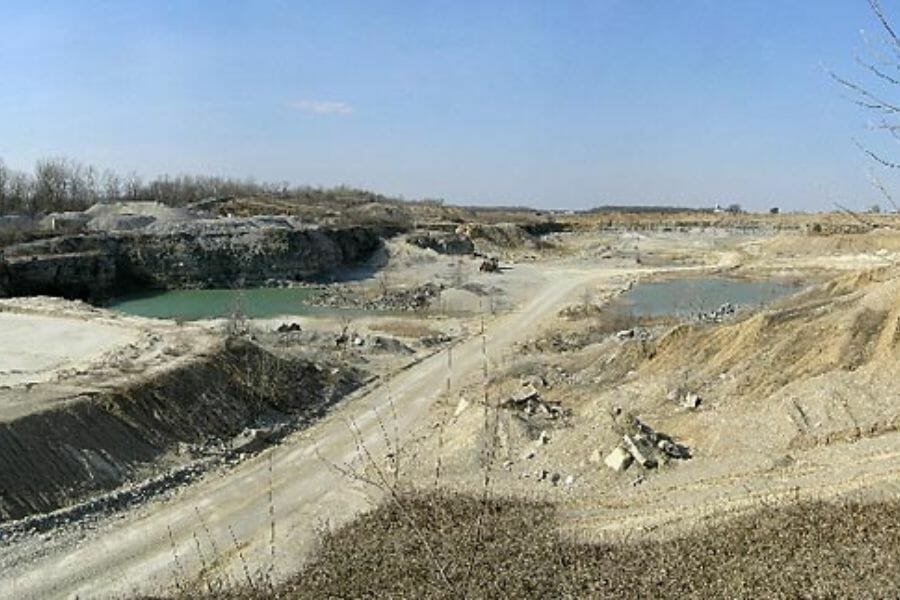
Richmond, Wayne County
The Debolt Quarry is worth visiting if you’re seeking a great place to collect crystals in the state. The unique history of this old limestone quarry, close to Rockport, dates back to the early 1900s. You can include this area on your list of top locations when finding gems in Indiana.
Originally a limestone quarry, the Debolt Quarry was mined for its high-quality limestone until the early 1970s. After that, it was abandoned and left to nature. Over the years, groundwater seeped in and formed beautiful crystal-filled cavities.
Geologically speaking, the Debolt Quarry is part of the Salem Limestone formation, which is known for its abundance of fossils and crystals. The area is also known for its karst topography, which means there are plenty of sinkholes, caves, and underground streams.
Where we found crystals at Debolt Quarry
In the entire Debolt Quarry area, we have collected various crystals, including apatite, calcite, and pyrite.
DON'T MISS OUT ON ANY GREAT FINDS!
While you're out searching for Crystals you're going to find A LOT of other interesting rocks and minerals along the way. The last thing you want to do is toss out something really interesting or valuable. It can be easy to misidentify things without a little guidance.
We've put together a fantastic field guide that makes identifying 140 of the most interesting and valuable rocks and minerals you will find REALLY EASY. It's simple to use, really durable, and will allow you to identify just about any rock and mineral you come across. Make sure you bring it along on your hunt!
France Stone Co. Quarry
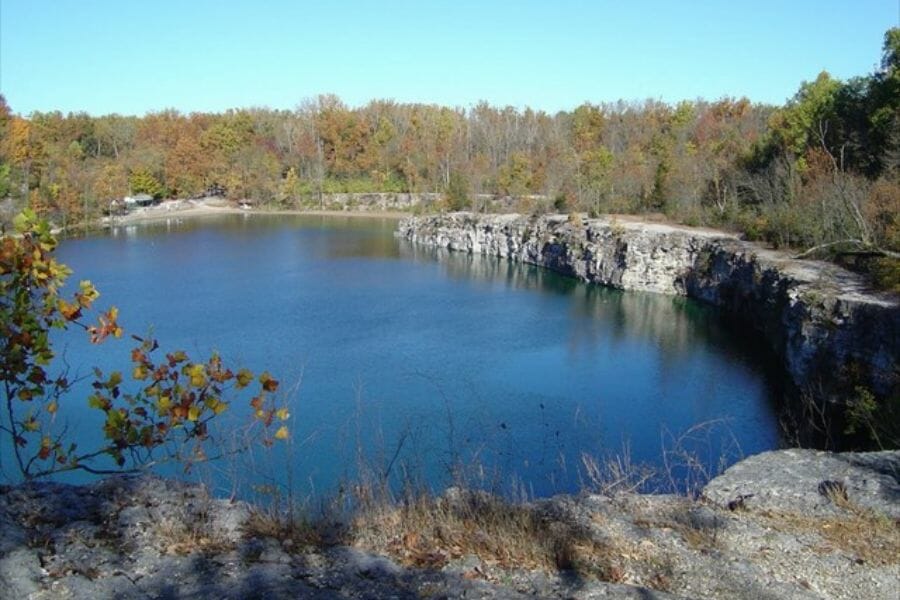
Logansport, Cass County
Another fantastic location to find crystals in Indiana is the France Stone Co Quarry. This quarry, located near Cloverdale, has a long history dating back to the late 1800s when it was first mined for its high-quality limestone.
The quarry is no longer operational today, but it has become a popular spot for crystal hunters looking for unique and beautiful formations. The quarry has impressive crystal-filled cavities, many with stunning purple amethyst crystals. Geologically speaking, the France Stone Co Quarry is part of the St. Louis Limestone formation, which is known for its abundance of fossils and mineral deposits.
Crystal hunters will love exploring the France Stone Co Quarry, as there are plenty of opportunities to find amazing crystals and other geological wonders. The quarry is also a great spot for photography, with its towering limestone cliffs and beautiful natural surroundings.
Where we found crystals at France Stone Co Quarry
Crystals of apatite, calcite, pyrite, and quartz can be discovered in the whole area of the quarry. You can determine your crystals value by reading this article.
Highland Creek
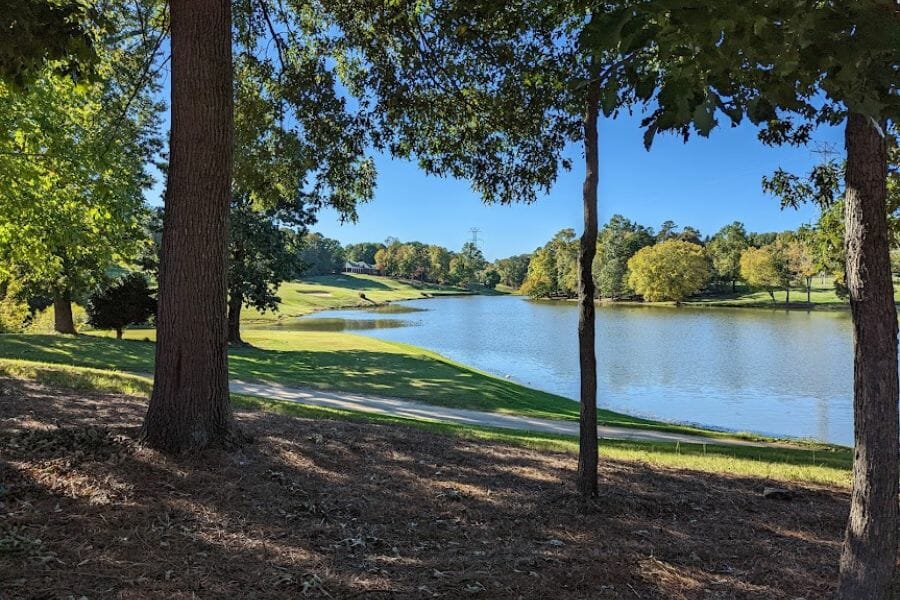
Highland Creek is a popular spot for crystal hunters looking to explore the natural beauty of Indiana. This creek, located near the town of Martinsville, is home to various beautiful crystals that can be found along its banks and in the surrounding area.
The creek is a great spot to find crystals, as they can often be found in the gravel and sand along the banks. The surrounding area is also rich with crystal formations, including geodes and beautiful calcite crystals.
Crystal hunters will love exploring Highland Creek, as it offers a beautiful natural setting and plenty of opportunities to find unique and beautiful crystals. It’s also a great spot for hiking and wildlife watching, so you can make a day of it and enjoy all the area offers.
Where we found crystals at Highland Creek
Diamond, garnet, hematite, pyrite, quartz, sapphire, and topaz crystals are primarily found along the numerous glacial gravel bars of Highland Creek.
Maumee River
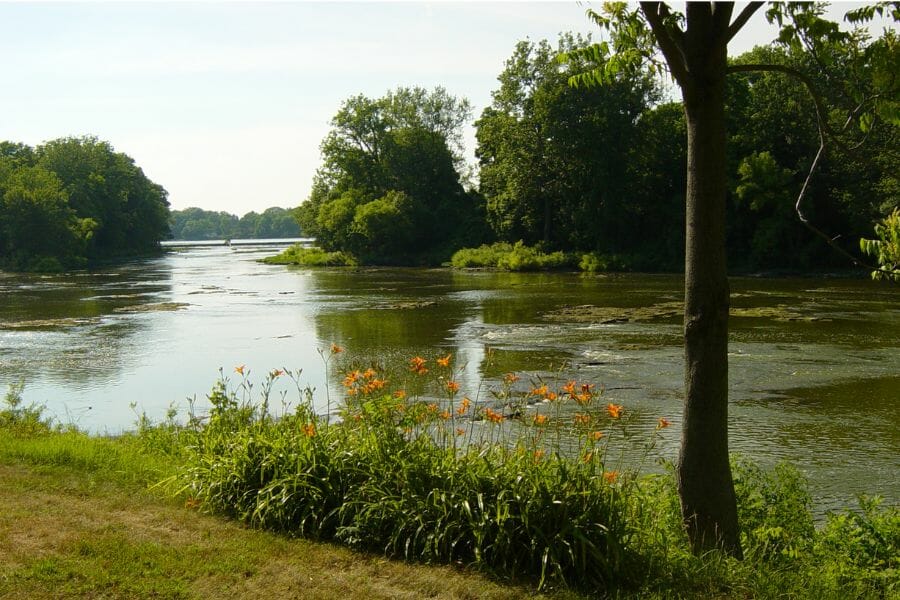
The Maumee River, which runs through the northern part of the state, has a rich history dating back to the early 1800s when it was an important trading route for Native Americans and early settlers.
Geologically speaking, the Maumee River is part of the Silurian and Devonian limestone formations, which are known for their abundance of fossils and minerals. The river is also known for its limestone cliffs and scenic beauty, making it a popular spot for outdoor enthusiasts.
Crystal hunters will be pleased to know that the Maumee River is home to various beautiful crystals found in the gravel and sand along its banks. The river is also great for finding fossils, geodes, and other unique geological formations.
Where we found crystals at the Maumee River
The Maumee River’s gravels and glacial float contain agate and jasper crystals.
Mud Pine Creek
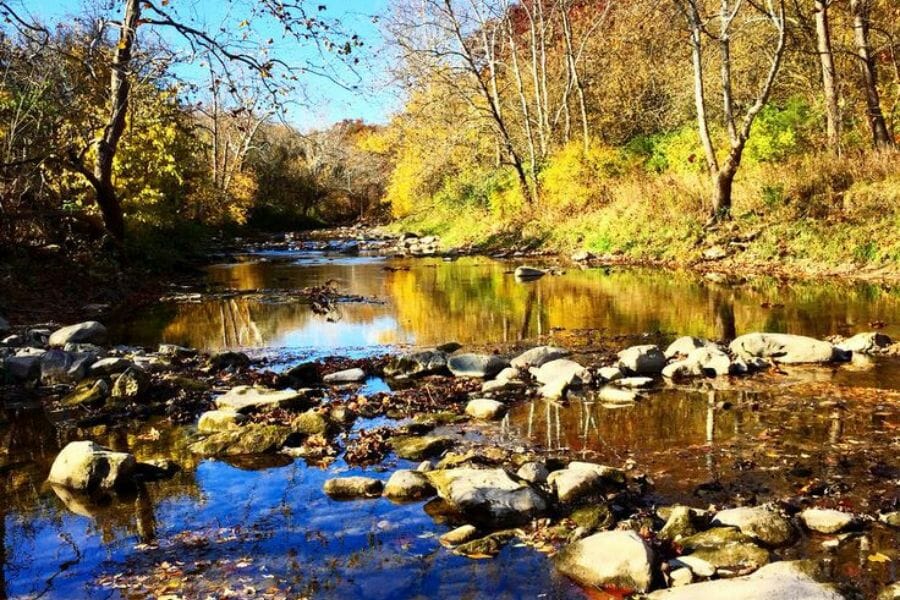
You’ll definitely want to add Mud Pine Creek to your list of must-visit spots. This creek, located near the town of Tell City, has a rich history dating back to the early 1800s when it was a hub for the timber industry. Geologically speaking, Mud Pine Creek is part of the Mansfield Formation, which is known for its abundance of fossils and mineral deposits.
The creek is also known for its beautiful natural setting, with towering limestone cliffs and lush green forests. Crystal hunters will be delighted to know that Mud Pine Creek is home to various beautiful crystals, including quartz and calcite formations.
Where we found crystals at Mud Pine Creek
We had the best luck finding pyrite crystals along the bluff of Mud Pine Creek.
Our Other Favorite Places For Crystal Hunting
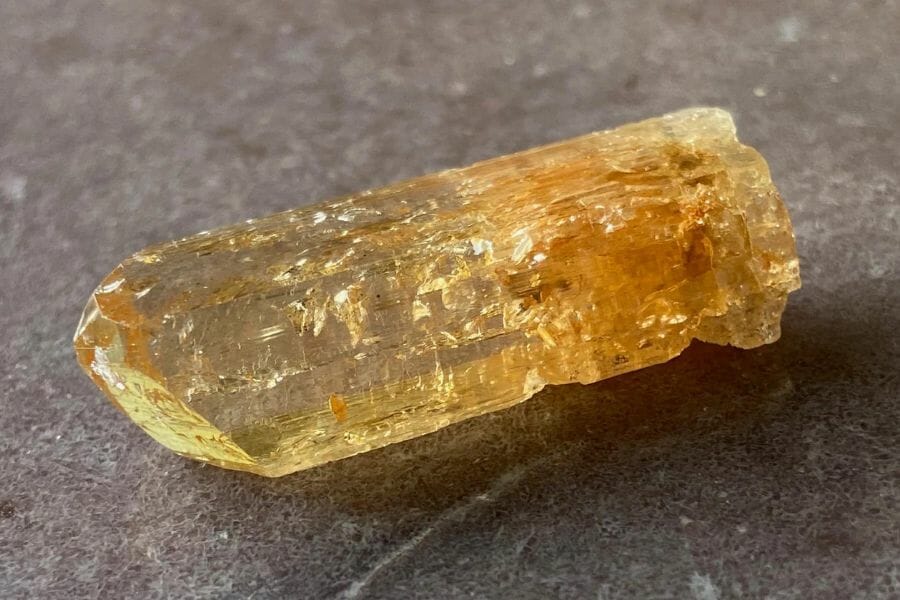
Unsurprisingly, the state offers many amazing places to look for crystals and dig for geodes in Indiana. We’ve included a list of additional options worth thinking about:
Where you can find crystals for free in Indiana
Let’s start by discussing a few locations where you can look for free. Although many of the most beautiful areas have entrance fees, other places are still free to visit.
| County | Location |
| Bartholomew | Meshberger Stone Co Quarry for calcite and fluorite |
| Brown | County-wide in galcial drift gravels for quartz and topaz |
| Decatur | Area stone quarry for chalcopyrite |
| Harrison | Area quarries of Croyden for calcite, fluorite, and quartz |
| Huntington | Erie Stone Co Quarry for calcite and pyrite |
| Marion | All area creek beds for moonstone |
| Monroe | Area quarries of Bloomington for fluorite |
| Monroe | Quimby and Stephen Quarry for pyrite |
| Monroe | All area stream and creek gravels and glacial moraines for diamond, quartz, and topaz |
| Morgan | Small streams through glacial drift in Gold Creek for garnet and sapphire |
| Shelby | Cave Stone Co. Quarry for calcite and fluorite |
| Washington | Abandoned quarry for calcite and selenite |
Other great places to dig for crystals
If you don’t mind shelling out cash, you can look for crystals in these other great areas. The price may vary seasonally and possibly be free at times. You should contact them first before visiting these locations.
| County | Location |
| Fountain | Norgan Company Coal Mine for pyrite |
| Knox | Area coal mines for pyrite |
| Parke | Area dumps, cuts, excavations, banks, seams, and coal mines for pyrite and selenite |
| Parke | Area dumps and coal mines for pyrite |
The Best Crystal Shops In Indiana
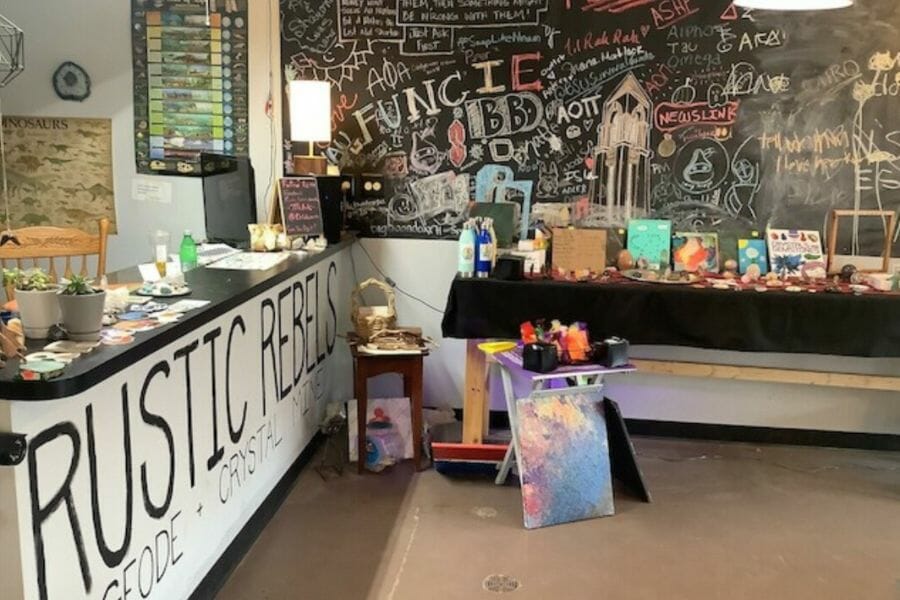
Because of the state’s wide array of crystals, many of us love making small purchases to round out our collections. These are the best crystal shops we could find if you’re looking for unique and stunning specimens.
- All My Relations – 7218 Rockville Rd, Indianapolis, IN 46214, United States
- The Crystal Lady – 192 W Joliet St Suite B, Crown Point, IN 46307, United States
- The Crystal Shop – 5845 Sunnyside Rd, Indianapolis, IN 46235, United States
- The Crystal Source – 110 S Van Buren St, Nashville, IN 47448, United States
- Crystal Wand Creations – 206 N Buckeye St, Kokomo, IN 46901, United States
- Geodes and Gemstones – 300 Hwy 35 N, Knox, IN 46534, United States
- Jox Rox Rock Shop – 4825 N Franklin Rd, Indianapolis, IN 46226, United States
- The Magick Candle – 6125 E Washington St, Indianapolis, IN 46219, United States
- My Inner Path – 1484 W 86th St, Indianapolis, IN 46260, United States
- Rustic Rebels – 1809 W University Ave, Muncie, IN 47303, United States
Additional places to find crystals in nearby states
If you’ve already tried all of our recommendations above or are planning a trip out of the state, you should check out our guides for neighboring states:
If you have any recommendations we haven’t covered please leave them in the comments below!

